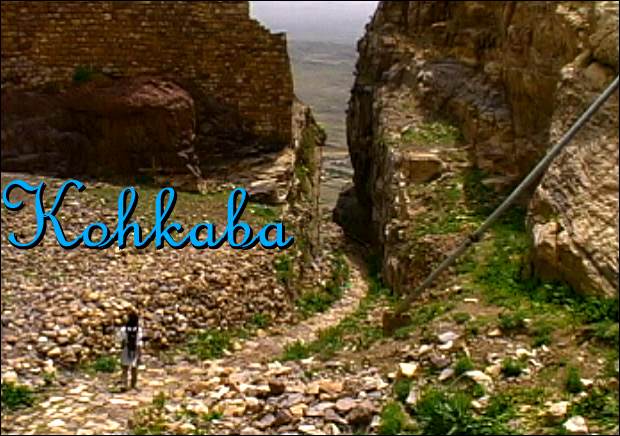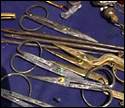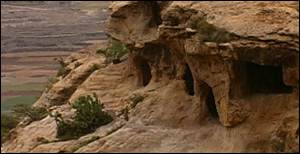
Hiking high above the plains...
Hiking in this region is especially great. The paths are challenging but the inclines are not too steep. On the paths you will meet many local people going about their daily routines, carrying bundles to their elevated villages from the suqs in the valley or herding goats.
In times of conflict, the people of Shibam would evacuate to the high dwellings and lock themselves inside the one main entrance to the walled city behind a fortified gate [left]. From there it was easy to defend the steep open path leading to Khohkaba.
Khohkaba was so easy to defend that it remained unmolested until the 1960's when it was bombed during the Yemen Civil War.
The architecture of Khohkaba is of the old, rough stone variety with many ornate features. The use of many different colored stones [left bottom] -- browns and greens -- makes the surrounding town look like a movie set rather than an actual small town.
Stone ruins, mules, sheep and children almost distracted us from the amazing view from the plateau. Below there were endless kilometers of fertile land, checkered with irregular golden pastures and olive colored fields. We found a small restaurant and took shai in it's charming stone courtyard.
Ahmed, our guide, brought us to the mountain path [top] leading from the gate of Khohkaba, down the cliff side to the valley floor. He said that it would take about an hour to reach Shibam, below.
The zig-zag path was made of wonderful stones. Each rock had a marbleized pattern of color. Nasser wondered aloud how the rocks would look in his back yard around his garden. Looking down the steep path to the distant roads, I wondered how he would get the rocks down! "Are those burial caves?" I asked Ahmed, pointing up the cliff walls to the small regularly shaped caves speckled along the cliff face.
"Yes, they are. Would you like to climb into one?" he asked. I scrambled up the rocky wall to a near by burial chamber. I had to duck my head to get into the tiny space. These caves are now empty and seldom see any use.
The blacksmiths were a reminder that almost everything in Yemen was hand made and recycled. The iron in these tools was likely once a door hinge, a nail, or even a piece of a car. Wooden articles are likewise fabricated from material with many past lives. Scissors and tweezers in a local shop were completely fabricated out of an old brass artillery shell [right].
Ancient caves were once used for burial tombs for families of Khohkaba. Today these caves are empty and are used to escape the heat or for overnight shelter for passing backpackers.
 Yemenis seemed to go out of their way to make their towns inaccessible. Khohkaba is a perfect example. Perched high atop a mountain peak, the stone fortress was built as a defensive position for Shibam, a region in the valley below.
Yemenis seemed to go out of their way to make their towns inaccessible. Khohkaba is a perfect example. Perched high atop a mountain peak, the stone fortress was built as a defensive position for Shibam, a region in the valley below.  In the Shibam, we wandered through the suq. The metal workers [left] expertise caught Gary's attention. Two young men worked in synchronized rhythm, holding the red hot metal and hammering it into shape.
In the Shibam, we wandered through the suq. The metal workers [left] expertise caught Gary's attention. Two young men worked in synchronized rhythm, holding the red hot metal and hammering it into shape.
